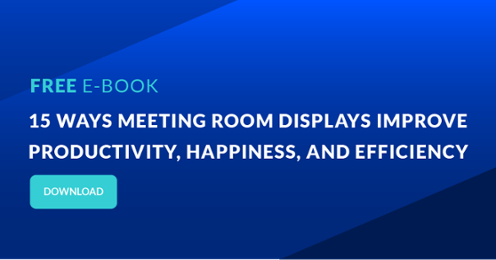Losing focus throughout your day can be harmful for your workplace productivity, and can destroy the workplace experience. Every day in the office, workers divert their attention to interruptions and other distractions, thereby diminishing efficiency and productivity. At the same time, too many employees complain about the work environment, and two out of three employees feel that their colleagues disturb too much.
At AskCody, we often talk about the "meeting room booking nightmare." This time, we will be talking about another nightmare that occurs at every workplace over and over again and contributes to negative workplace behavior. The famous 'tap on the shoulder'-nightmare. In this post, we discuss the cost of being interrupted.Interruptions at work are killing productivity
“Hey, do you have a second?” - six words that can destroy productivity for even the best of us. When repeated over and over and over again over days, weeks and months, “having a sec” can rob an otherwise productive and effective person of hundreds of hours of good work. Some of us might believe that the open office arrangement where everybody can "collaborate" and "interact" with one another is the one to blame here, and moving from this to cubicles or smaller offices could be leaving those taps on the shoulder behind.
Being put behind bars in smaller offices and empowered with great productivity tools like Microsoft Teams or Viva Engage, Slack, Meta Business Suite, and others, do not just evolve to empower our best behaviors; we also have a sneaky way of using them to fall back into bad habits, too.
When you are focused, in a good flow and rhythm, productive and getting the job done, the worst thing is to be distracted with something that is not urgent. Perhaps your good colleague John did not mean for it to be a “tap on the shoulder.” He might have said, “whenever you come up for air and take a break, let me know.” But it does not matter what he meant. You were distracted!
The cost of workplace distractions
A 5-minute distraction is not a 5-minute distraction! It is as simple as that. Every time someone asks if “you have a second,” here is what happens. “A second” probably means that a 3-5 minute conversation is about to take place. But the cost of that conversation is not just those 3-5 minutes. Most of us do our best work when we are focused. And research suggests that the time-cost of a single distraction—that is the time it takes us to get back into deep focus after being pulled out—is 23 minutes.
For example, you get tapped on the shoulder—either online or in person—three times a day, that means that you are spending at least an hour of each day not fully focused on your work, thanks to mental distractions.
It gets worse
Of course, a meeting cannot happen with just one person. It requires the participation of at least two individuals and often more. When we consider the impact of distractions in meetings, the consequences become even more significant. Let's take a moment to imagine the scenario: a team of five people, each experiencing daily sub-optimal hour due to interruptions. If we multiply this by the number of workdays in a year, which is approximately 260, we end up with a staggering 1,300 hours of compromised focus annually. This accounts for more than 162 workdays lost.
Unfortunately, many businesses have come to accept distractions in meetings as a necessary evil. Some business owners or leaders resign themselves to the belief that people need to distract each other in order to get their tasks done. However, this acceptance should not be the norm. It is essential for businesses to realize the true cost of these interruptions, not only in terms of lost productivity but also in the negative impact they have on the overall organization.
How to win your time and productivity back
Yes, there will be times where you need to distract someone. When there is a fire to be put out, there are ones that need to do it. But that—'tapping' them and pulling them out of whatever they are working on—should be the extreme exception, and not the norm that it seems to have become in way too many workplaces. But what can you do prevent tap on the 'tap on the shoulder' interruptions?
1. Make it easy to see if you are free, busy or away
What if, instead of compromising five hours per week on unscheduled distractions, we could cut it to a lot less? A low hanging fruit is to make it easy for your team members or colleagues to see if you are free or busy. You can even set your status to being 'away', i.e being out of office, and make a note to your team, to notify about when you are back at the office or available for messages and calls again. A visible 'status' eliminates the need for many interruptions, calls and message spamming in the group chat of your team, who otherwise wonders why you are unreachable. Of course, only if people respect your 'busy status'.
A cool tool for that is the different busy-light solutions with a green or red light that connects with your Outlook, Microsoft Teams, or other online collaboration platforms. That way people easily know if you are free for a chat or if you are occupied and need to focus on your task.
2. Turning off notifications
While Microsoft Teams, Viva Engage, Slack, and Meta Business Suite are widely popular and effective tools for communication and collaboration, it is important to acknowledge that they are not without their drawbacks. One of the most significant pitfalls of these instant messaging solutions is the perception problem that can arise in email and online communication.
The constant influx of messages and notifications from these platforms can be overwhelming and disruptive to productivity. Employees may feel pressured to respond immediately to every message, no matter its urgency or importance, leading to a constant state of distraction and reduced focus on important tasks.
To mitigate the challenge, it is essential to establish clear guidelines and expectations for communication using these tools. Encouraging employees to be mindful of their tone and intent when composing messages can help prevent miscommunications. Additionally, setting boundaries and encouraging employees to turn off notifications during focused work periods can create a more conducive environment for deep work and concentration.
3: Use asynchronous communication tools for communication
Another easy win is to use asynchronous communication tools. Tools that let you have conversations where all participants do not have to go back and forth in real time. Our primary hubs and solutions for this are Microsoft Groups, Planner, and OneNote for discussing internal projects, ideas, roadmaps, and timelines. It is great for centralizing collaborative lists, plans, and ideas and does not disturb your colleagues when you add a new subject or update something. People can check in when they feel for it, or simply just subscribe to a daily or weekly digest-mail of all the updates.
4: Get an AskCody Meeting Dashboard for people
Meeting Dashboards for people, provide you with an instant, chronological overview of your employees' activities and events throughout the day. Thus, you can take control of your time and easily let co-workers know if you are free or busy. They will let your colleagues know when you are in a meeting, busy with a deadline, out of office or free to chat – all integrated with your Outlook Calendar events and status. Using AskCody, you can inform your co-workers on what you are working on right now, so that they can easily see if/when you are available. Thus, saving valuable office time, increasing daily productivity and improving the workplace behavior and environment.
Put up in the right location in the company Meeting Dashboards can reduce cost, unwanted interruptions by co-workers, and save time. You can instantly transform irrelevant interruptions and wasted time into value-adding work activities. It helps you cope with the open office environment challenges and enables you to reach new heights in productivity and collaboration.
Conclusion - How to avoid workplace distractions?
Workplace distractions and interruptions can significantly impact productivity and efficiency. The constant "tap on the shoulder" can lead to hours of lost focus and compromised work quality.
However, there are steps that can be taken to reclaim your time and productivity. By implementing tools such as visible status indicators, turning off notifications, and using asynchronous communication tools, you can minimize interruptions and create a more focused work environment.
Additionally, utilizing tools like AskCody's Meeting Dashboard can provide a comprehensive overview of employees' activities and events, further enhancing productivity and collaboration. By taking control of workplace distractions, you can optimize your time and create a more productive and satisfying work experience.
To learn more about how to improve workplace behavior and increase productivity, continue exploring our website, or read our free E-Book for valuable insights and tips.




